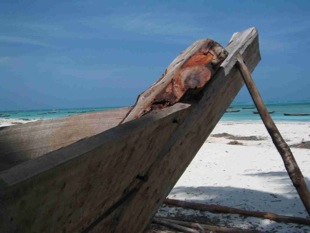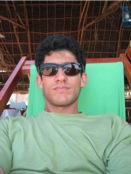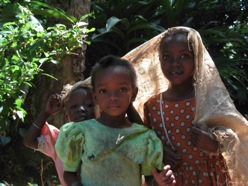

Nungwi to Stone Town
January 14, 2003
On the way back to the taxi we stop at their shop to buy the freshly dried spices on the cheap. Six nutmegs, still wrapped in mace for 60 cents. Freshly dried cinnamon bark in huge sheaves tied with twine for $1. All fresh from the farmer.
Back on the road we make our way the rest of the way south to the whitewashed coral of Stone Town. Narrow streets with narrower lanes don't slow drivers too much. If it's too narrow for even a small car, scooters go just as fast. Once we are settled into our hotel we go into town. First a quick tour of the Anglican Church, built right over the old slave market, then into the narrow streets to see what the shops have to offer.
Serengeti Plain & Ngorngoro Crater
January 19-21, 2003
After a cold night bundled in our sleeping bags we rise with the full moon shining just above the horizon. As we drive along the crater rim to the floor access road we watch the sun turn the sky orange and red behind the silhouettes of Mount Meru and Kilimanjaro. Crystal clear air reveals the crater floor below, covered in a sea of fog (Wilson told us it was the first time in his three years of guiding that he had seen mist actually on the crater floor). Our descent takes us from the cloud forest of the rim, trees dripping with vines, to the relatively dry grassland of the crater floor. As








Zanzibar, a place full of ancient mystery. Spices and slaves made the island rich and a good climate once brought the Sultan of Oman and his court. But Zanzibar's current draw is its beach resorts. We spend our first couple of days at Nungwi, on the northern tip of Zanzibar Island. White sand so fine it's almost like mud, turquoise water nearly as warm as the air, and cooling breezes make for the perfect break after our time in Malawi. Nungwi itself is a small, Muslim fishing town. For the locals the beaches are staging points for their nightly fishing trips or workshops to repair their dhows and nets. I guess some of the locals do play in the water, but the children do it fully clothed.
avoidance (90 minutes to go 40 kilometers), we stopped off at a small spice farm. Omar, grandson of the Omani founder, is our guide. He walks around what seems like an overgrown garden, plucking leaves and handing them to us. "Smell," or "Taste," he says. Always adventurous in
Since the only activities on offer are sitting on the beach and diving, we head down to Zanzibar Town (aka Stone Town) a day ahead of the group, along with Matt & Deb. On the road down, which was a lesson in pothole
the food department I immediately oblige. Amy is almost as quick, and eventually Matt & Deb do as well. Aromas and strong flavors are quick to follow. Cinnamon, cloves and
nutmeg, all from tree leaves. Omar even strips some of the cinnamon bark for our enjoyment. One of the young boys (they start working very young) climbs up another tree and drops some small, green fruit. Aromatically familiar. . . cloves (which are the dried fruit). An older man shimmies up a narrow coconut palm and drops each of us a green coconut, and some dried ones as well. Artfully split open they yield their water, not too sweet and very refreshing, and the sweetest coconut meat I've ever had. We also sample cardamon pods, still green, plucked from runners along the ground. Another vine, climbing up a tree, twirling to yield tiny green fruit. . . crisp, spicy black pepper.
As we wander some more I realize that these precious plants are everywhere. What looks like a jumbled mess is carefully organized, with spice trees supporting vines, and shading low bushes. A cook's dream forest, carefully balanced to maximize yield.


Close buildings may provide protection from the tropical sun, but they also make navigating around more of an adventure. Streets twist and turn every 20 feet, scooters buzz by and touts vie for the attention of every fair-skinned passer-by. The shops sell tourist trinkets, brightly colored cloth and some nicer works of art. I guess our failing health (our stomachs were taking a turn for the worse) colors our judgement a little, and makes both of us impatient with the touts. We find what respite we can in cool restaurants, eating the richly flavored food and sipping cold sodas.
Another day-and-a-half wandering around the markets before we catch the ferry back to Dar es Salaam. Our group is just not in good shape, all with the same stomach ailment, so we fail to enjoy the beautiful ride over the sea. Our fast catamaran ferry passes dhows carrying cargo up and down the coast, but we are more focused on our own stomachs and those of our fellow travelers. Fortunately we soon realize the seriousness of our condition and each take Noroxin over the next few days so are well enough for our next adventure further inland.
--Z
After taking a very restful day at Masai Camp in Arusha (and starting a course of Noroxin) we are picked up early by Wilson and Steven for the long drive to Serengeti. Amy and I ride with Matt & Deb in Wilson's Land Cruiser, while Jacques, Mel and Yun are with Steven. Martin, Jenny and Georgie remain behind, to rest and recover.
Our first day's drive takes us down into the Rift Valley, 1500 feet up the steep escarpment to the base of the Ngorongoro Volcano, and then up another 2000 feet to the rim of the crater. Here we lunch close under the watchful eyes of several maribou storks, and hunch over to protect our food from the swooping black kites. (We even observe why these raptors think they can steal food: several tourists think its fun to throw food into the air and watch the black birds catch.) Then we go down the back side of the volcano, to its ashfall, now known as the Serengeti Plain. How lucky we are to be there in January, with green grass from the recent rains and huge herds of wildebeest and zebra down from the Masai Mara.
Our first real game drive here starts early the next morning, just as the sun starts to lighten the sky. Crisp










air and acacia trees silhouetted against the orange and red sky are just like the Africa of my imagination. Animals are everywhere, mostly impala, waterbok and gazelle at first. Then we are very fortunate to spot a leopard in a tree (too far even for my 500mm lens). Later we are mock charged by a lone bull elephant, who then proceeds to scratch himself all over a large tree. One of the highlights of the morning was watching a pride of three lionesses climb into a tree to catch some cool breezes.
We return to camp for brunch, which our cook, Rashid, has laid out in a magnificent spread. Then we drive back across the plain to the crater rim. Enroute we pass through wildebeest herds so thick they have to clear out of our way. Climbing back up to the rim we pass a "commercial" Masai village. Amy and I decide the $5 entry fee is too steep, but Matt & Deb decide to go. "I'm glad I went, but I wouldn't recommend it to anyone else," Matt reported on his return.
we enter the mist we retreat to the warmth of the truck, but as soon as the first gazelles come out of the fog I stand up, braving the cold and constantly wiping my glasses.








As we drive through this silent world animals suddenly appear, still laying down from the night, with the dark wildebeests and buffalo only as shadows. As the rising sun slowly burns the cloud away it
provides a magical light, sometimes revealing and sometimes hiding the numerous animals.
I guess the best part of the Ngorongoro Crater is not just the sheer density of animals, nor the variety (which includes elephants, black rhinos, lions, hippos, countless gazelles and birds and even some
sable). It is the whole package. Standing on the floor of an ancient volcano which collapsed into a 10 mile wide crater. The mystical quality of the sunlight burning through the mist. Dark green mountains fully surrounding the pale grassland. Pink flamingos seeming to walk on water. All of the animals seeming without fear of man. Almost like paradise.
Though my muscles ache and I am bruised from standing through the roof, I am very reluctant to leave. Rashid eases the departure with another enormous feast before we take the steep road back down to Arusha.
--Z


Photographs and Text: Copyright 2002 & 2003, Zachary Maler & Amy Leffert